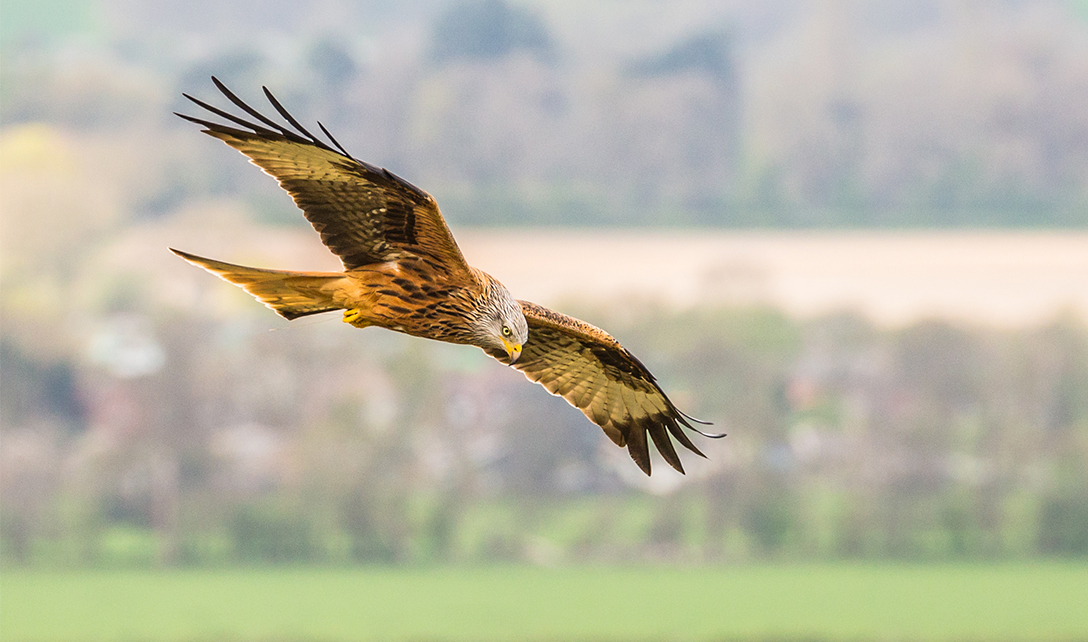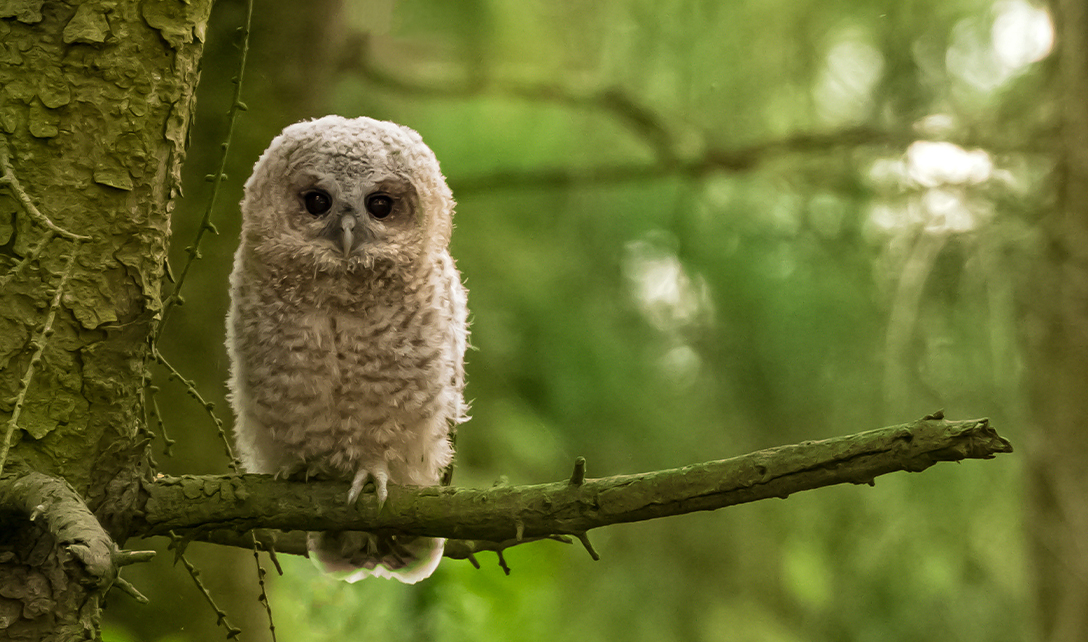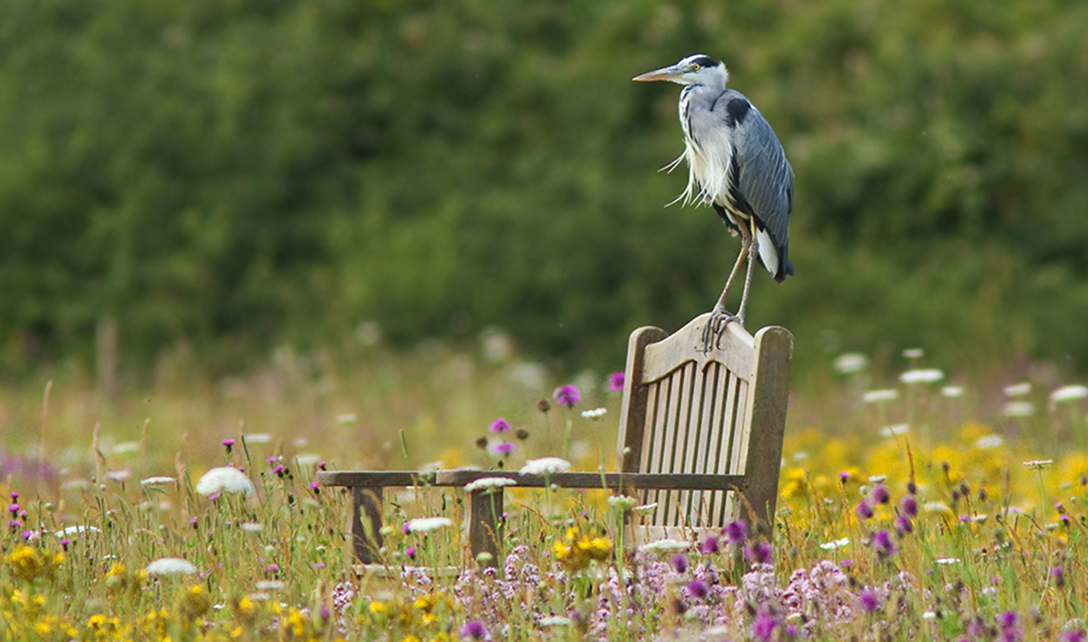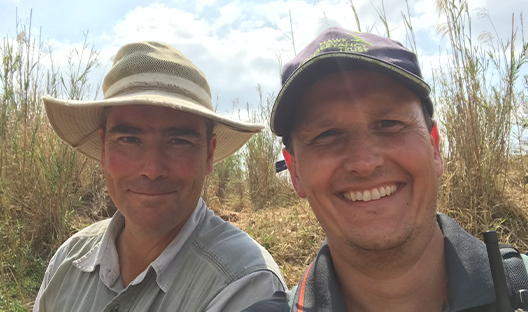At Investec, we are passionate about caring for the environment and wildlife, and we believe that protecting critically endangered species and their habitats is the only way to ensure their survival for future generations.
In the UK, conservation efforts have been pivotal in bringing some birds of prey species back from the brink of extinction. Red kites are a remarkable success story, with populations climbing 413% between 1995 and 20181, after having dwindled to just a handful of birds at the beginning of the 20th Century.2
But there’s still much more work to do. Which is why we’re delighted to be partnering on a number of new projects with the Hawk Conservancy Trust (the Trust), a charity dedicated to the conservation of birds of prey.
Investec's partnership with the Trust will support the rehabilitation of birds of prey found here in the UK and their release back into the wild, as well as an education programme that encourages children from city-centre settings and disadvantaged backgrounds to connect with nature, experiencing the magnificence of these birds of prey first-hand. We will also be supporting a vulture poisoning response training programme in Southern Africa to protect the declining population of these critically endangered birds.

Protecting our environment | Investec Corporate ResponsibilityWe're delighted to work with the Hawk Conservancy Trust. Their passion for what they do mirrors our people’s passion about making a difference. We’re excited about what we can achieve together and reconnecting hands-on with nature.
When the partnership opportunity was presented to Investec, the team immediately saw the alignment of the conservation work being done by the Trust with the work Investec has been doing through our partners in South Africa. The Trust works very closely with the Endangered Wildlife Trust (EWT), with which Investec has partnered since 2013.
“It’s exciting to work on a conservation project that involves both our UK and South African businesses,” says Geraldine Fleming, Investec’s Head of Conservation.
“Even when located so far away in South Africa, our UK colleagues have always been strong supporters of our rhino and wild dog projects, and we’re so pleased that we may be able to have more of an impact locally in the UK, on such important and iconic birds of prey.”
Second chances
Birds of prey may not seem an obvious piece of the conservation puzzle, but they're an important one. They are often apex predators, so a thriving population indicates a healthy ecosystem.
When birds of prey become endangered or extinct, it's a sign that all is not well. And we already have plenty of red flags that ecosystems are under threat.
The Intergovernmental Panel on Climate Change recently issued a climate 'code red', warning that meaningful action is immediately needed to avoid catastrophic consequences for the environment.3
Scott Jones, Divisional Director at Investec Wealth & Investment, is the Hawk Conservancy Trust's Chairman. The importance of conservation is key to his role at both organisations.
"People see fires, floods and global warming and they worry about what the world will be like for their children and grandchildren in 50 years' time," he says.
"The message is clear: we've got to start taking care of the world. We're not going to get many second chances."
At the Trust, second chances are something of a specialty. The charity treats, rehabilitates and releases birds back into the wild at its on-site National Bird of Prey Hospital™ and rehabilitation aviaries.
From May to August this year, there were 75 birds of 10 different species on the patient list, including 28 tawny owls, 15 kestrels, seven buzzards, seven barn owls, five red kites, four sparrowhawks, four peregrine falcons, two goshawks, two hobbies and one little owl.
Of these, currently 52 have been released back into the wild for their second chance.
The hospital is one of the key areas that Investec will support this year. Rescuing injured, sick or orphaned birds of prey, helping them to recover and giving them a second chance at life is hugely rewarding for the Trust's staff.
Dr Campbell Murn is Head of Conservation and Research at the Trust. He's also a biological sciences lecturer and one of the world's leading experts on vultures.
"A lot of admissions to the hospital are from birds that are starving or just plain exhausted," he says.
"First-year survival rates for many birds are low. They either don't learn to hunt or don't make it through winter. We get a lot of first-year birds that are really struggling, and they're the ones that are very satisfying to help because we're giving them another chance."
The Trust has four key areas of activity: conservation, education, research and rehabilitation. In practice, these areas are all interconnected.
So while the hospital's primary focus is rehabilitation, its extensive admissions database – which goes back over 20 years – provides crucial insights for the Trust's research activities.
For example, analysing the data shows the types of threats birds of prey face in the UK, as well as what species are most affected by these threats. In other words, the Trust's rehabilitation efforts inform its conservation, research and education work, and vice versa.
Learning more about the factors that affect birds of prey populations is crucial not only to the Trust's work here in the UK but also in Southern Africa.

Threats to UK birds of prey
Shooting, trapping, poisoning and other forms of illegal persecution remain one of the biggest threats to UK birds of prey. There were 85 confirmed incidents of persecution in 2019, the last year for which we have figures.7
In addition to deliberate poisoning, which is thankfully quite rare, many British birds suffer secondary poisoning when people put down rat poison. Rats and other small mammals, like voles and mice, consume the poison and are then eaten by birds of prey.
Lead is another issue. It's a neurotoxin that's still used in ammunition in this country, so it can be ingested by birds of prey when they eat the carcasses of hunted animals that aren't retrieved.
More broadly, agricultural intensification and other land-use changes continue to pose a threat to birds of prey and their habitats.
Supporting vultures
Vultures often get a bad rap.
As carrion birds that feast on carcasses, they're often depicted as worrying omens in Western cultures. And, admittedly, some suggest they're not the most conventionally attractive creatures in the animal kingdom.
But most people who spend time with vultures will tell you that their reputation is undeserved. They are incredibly intelligent birds, and while beauty is in the eye of the beholder, seeing vultures in full flight is awe-inspiring.
Sadly, vulture populations worldwide are under serious threat, with 11 of 16 vulture species at risk of extinction in Africa, Asia and Europe within our lifetime.4
In South Asia, a staggering 99.9% of Asian white-backed vultures and 97% of long-billed vultures and slender-billed vultures were wiped out due to the use of diclofenac – an anti-inflammatory drug for cattle – finding its way into the food chain.5
The drug has since been banned in Pakistan and many other countries where vultures had previously thrived. But the damage has already been done.
Furthermore, poisoning remains a major threat worldwide. In Africa, ivory poachers lace elephant carcasses to deliberately target vultures. This is because carrion birds often give away poachers' locations to the authorities by circling over recent kills.
In South Asia, a staggering 99.9% of Asian white-backed vultures and 97% of long-billed vultures and slender-billed vultures were wiped out due to the use of diclofenac.
It's not uncommon for several hundred vultures to be killed in a single mass poisoning. Many vultures are also killed in secondary poisoning incidents when they feast on the bodies of carnivores poisoned by farmers who are trying to protect their livestock from predators, for example.
"More species of vulture are threatened, endangered or critically endangered than in any other group of birds in the world," Campbell explains. "That's one of the reasons we use a lot of resources trying to protect them."
"Another reason is they're so vital ecologically. They clean up carcasses before they rot, which can affect disease transmission and prevent water contamination. If you take vultures out of an ecosystem, there are serious consequences."
This is why the Trust – working with EWT – launched International Vulture Awareness Day. Taking place on the first Saturday of September each year, it highlights the predicament of these unfairly maligned birds and encourages conservation efforts across a number of countries.
Investec helps support vulture conservation in Southern Africa by working closely with the Trust and EWT to provide poison response kits and training to park rangers, local police and other authorities. The kits are used to clean an area, take samples and provide first aid to any surviving vultures that are poisoned.
We are also very proud to be involved in long-term breeding and monitoring programmes in South Africa to measure the impact of efforts aimed at boosting local vulture populations.

Investec and the Trust share a common goal to create a lasting positive impact for these majestic creatures, their habitat, and also our own species, by getting people closer to nature. We hope this is the start of many great achievements together.

Tawny owls and 'branching'
The birds of prey most frequently brought into the Trust's hospital are young tawny owls. Thankfully, they're not usually injured. They've been brought in by well-meaning people who've found them on the ground and assumed they fell from a nest or are orphans.
However, young tawny owls actually go through a process called 'branching' where they climb, jump and flutter around the trees and ground around their nest. It's perfectly natural, and their parents will usually continue to feed them.
Unless obviously injured, a young tawny owl is often best left alone. Although, if they're on the ground, you might want to pick them up and put them in a bush or low-hanging tree branch to protect them from predators6. If you're ever in doubt, please contact the Trust on 01264 773 850 for advice on what to do after finding a tawny owl chick.
Educating audiences
Here in the UK, the Trust's educational activities play a key role in helping people learn more about birds of prey, including vultures (which aren't native to this country).
Every day, the Trust puts on demonstrations, where the birds show off their stunning aerial manoeuvres in flying displays. The shows are integral to how the Trust inspires visitors about birds of prey and the importance of conserving them.
The birds always have a choice whether or not to take part. And it's not uncommon for one to fly off momentarily during the demonstration to explore the area; they are free to do that.
Campbell believes the best way to make people more passionate about birds of prey is by seeing them in person. This is particularly useful for birds with bad press, like vultures.
"When you see a vulture up close, you can see how bright they are and how beautifully they fly," Campbell says. "Through our commentary, you'll also learn more about the threats they face.”
"It's rare for somebody to leave here without thinking: 'Maybe I was wrong. I quite like vultures now!'"
"Sometimes, just one little thing can be the catalyst for a person to change their outlook. That's a big thing. It's special to be able to do that.”
For Scott, early education is particularly important for inspiring people to become passionate about conservation. His love for wildlife and nature developed when he was young.
"We had always been an outdoorsy family when I was growing up," he explains.
"We spent a lot of time travelling up and down the UK to Devon, Cornwall and other idyllic countryside locations. As a result, I've got many treasured childhood memories of family days out close to nature."
Other children are not so lucky. At Investec, we want to do our bit to change that by giving children the opportunity to start learning about the world they live in from a young age.
Hopefully, like with Scott, this early inspiration will follow them well into adulthood.
To quote Baba Dioum, a Senegalese forestry engineer:
"In the end, we will conserve only what we love; we will love only what we understand; and we will understand only what we are taught."
Investec is therefore launching a new educational project as part of its partnership with the Trust.
The initiative will give 75 children from city-centre settings and disadvantaged backgrounds the chance to spend a day immersed in nature at the Trust. While there, they will learn about the importance of conserving our natural world and be given a hands-on introduction to practical wildlife research and conservation.
Penny Smout, the Chief Executive of the Hawk Conservancy Trust, says the education programme will also improve our collective understanding of the wellbeing and health benefits of engaging with nature.
"Working with Investec to connect these children with nature and wildlife is really exciting, and we hope it makes a pivotal impact on their lives," she explains.

Reg's Wildflower Meadow
Around 95% of the UK's chalk downland has been lost over the last 50 years, which is a huge loss given its unique biodiversity.8 Chalk downland can contain up to 40 different types of plant in just one square metre of ground9, as well as many rare insects.
The Trust created seven acres of new chalk downland in 1995 in memory of its founder, Reg Smith. Back then, the Trust planted seeds of just 35 different flowers and grasses. Now, there's approximately 60 different species of meadow plants and nearly 30 tree species.
Looking to the future
A common theme among people who have visited the Trust is that when they've been once, it's hard not to keep coming back. That's certainly true for Scott and Campbell, who both began their journey to the Trust at a second-hand book store.
Scott's father had bought him two birds of prey annuals when he was a boy. He says he was mesmerised by the photos of these majestic birds.
"Several years later, a school friend took me to the Trust with his family. I was instantly hooked. There, in the flesh, were the birds I'd only ever seen in photographs," he explains.

Empowering young people | Investec Corporate ResponsibilityWe're only able to do the education programme because of the link with Investec. It wouldn't be possible without their help. We really hope it can grow into something much bigger.
For Campbell, he had been holidaying in the South West and bought a book about falconry at a local shop.
"When I first moved to the UK, I thought that falconry was something they only did in the Middle Ages. It wasn't something they practised back home in Australia," he says. "But it's quite an active hobby and field sport here."

The book had an address for the Hawk Conservancy in the back. Coincidentally, just a few months later, a job at the organisation was being advertised, so he decided to apply, thinking it would be a fun job for the summer.
Using the address from the book, he wrote an application letter to the Hawk Conservancy's founder and then-director (now Life President) Ashley Smith. He got the job. That was back in the '90s, so it's safe to say it was more than just a summer job.
Other visitors share similar stories of having a lifelong affection for the Trust.
"We have people bringing their grandchildren to the Trust because they came when they were younger. They'd been touched by the place or had that little nugget of inspiration that comes with a visit," Campbell says.
"They bring their children, and then their children bring their children, and that goes on and on."
In many ways, it's a perfect illustration of what conservation is about: preserving something special for future generations.
Whether it's an injured bird, a critically endangered species or even a dusty old book – Investec believes there is great value in giving things a second chance.
And by strengthening our partnership with the Trust, we believe our efforts to do that can only improve.

From private banking to wealth management and investment services, you can receive tailored financial solutions, whether you are aiming to actively grow your wealth or seek optimal returns on your capital. We can help fuel your success by building a relationship with you for the long term.

Access a comprehensive range of solutions spanning capital, advice and treasury risk management. As an international corporate and investment banking business, we work with growth-orientated companies, institutions and private equity funds.

Whatever your clients’ goals and ambitions, our flexible range of intuitive, market-leading products and services help you deliver on their needs, enhance your reputation and reduce your admin burden, freeing up more time for you to focus on financial planning.
Search articles in




